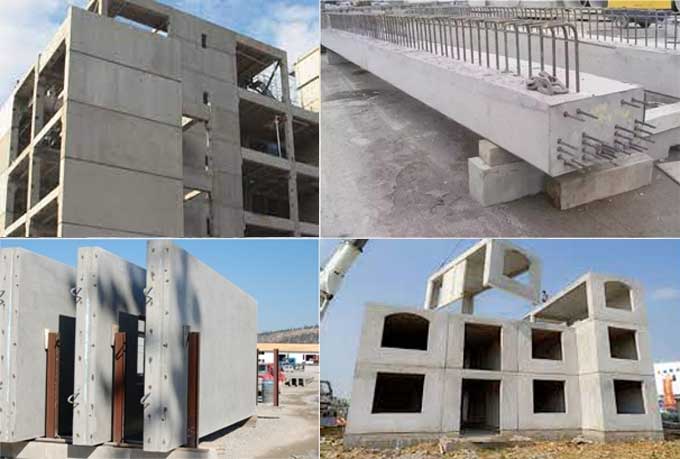
Everything you need to know about Precast Concrete

The housing shortage is one of the major problems facing developing countries such as India today, as well as the labor shortage problem.
Precast concrete structures are being used more and more in construction due to their fast construction times and their ability to reduce construction costs.
This is because construction costs have been rising in recent years, and quality and timely delivery have come to have more prominence for developers.
Precast Concrete
Precast concrete is a type of concrete that is mixed and cured off-site after being prepared in a factory, workshop, or other location.
Precast concrete is created in a controlled environment at the factory. It is not put up on the web until all of the elements have been cast and have had time to solidify. Precast concrete is a versatile material that can be simple, reinforced, or even pre-stressed.
Typically, reusable molds are used to create precast concrete in a regulated manufacturing setting. To create a full structure, precast concrete components can be simply joined to one another. Numerous structural elements, including wall panels, beams, columns, floors, stairwells, pipelines, and tunnels, are made of precast concrete.
Features of Precast Concrete
Precast concrete?s Quality
In factories or facilities, precast concrete components are made. To assure the best quality and strength in the specified forms, colors, and textures, such organized and accredited companies make precast concrete in strict accordance with laws and regulations under completely factory-controlled circumstances.
The manufacturing process and overall operation of the unit are the main subjects of the inspections.
Flexibility features
Precast concrete is a very durable kind of construction. Concrete that is dense and extremely durable is manufactured using a low water/cement ratio together with good compaction and curing in a controlled industrial setting.
Precast concrete is resistant to impacts, corrosion, abrasion, weathering, and other effects of aging. Costs for operations and maintenance are decreased.
Fire resistance
Precast concrete has the capacity to resist fire, and it produces secure structures that aid in defending humans from fire. Equipment and the building itself are also protected. It could also assist lower the cost of your home insurance.
Benefits of Precast Concrete
Concrete precast is a fast-setting material
Precast concrete is incredibly quick and simple. Construction with precast concrete will help you save time, lower your risk of project delay, and prevent any financial losses. Precast element design and manufacture can begin while the construction site is being surveyed or prepared for construction.
Due to the controlled atmosphere of the casting facility, production is also unaffected by the weather. Large precast panels will also shorten the time needed to finish the structural work. As a result, work may start sooner on other professions like painting and electrical wiring.
Flexible structure
For structures that have to be structurally stable over a long period of time, precast concrete is often used.
A precast manufacturer can provide guidance to you on how to design your precast product to be durable. Increasing the life of the building by placing reinforcements in a more controlled manner has the benefit of increasing the durability of the building.
Cost-efficient
Precast concrete combines the high standard of industrial manufacturing with a material that is reasonably affordable.
Concrete constructions may be repaired and maintained for relatively low prices. Therefore, there is no need to sacrifice quality in order to cut expenses; instead, pick the most efficient approach to employ the resources that are already in your area.
Safety features
The steel-reinforced concrete used in precast structures has the strength to withstand impacts, blasts, earthquakes, tornadoes, and floods that can occur during the construction process.
Fully customizable
In pre-casting plants, advanced technologies are used to produce a product that is better in quality, which is reduced tolerances, thinner sections, and engineered solutions in comparison to concrete that is cast on site.
Drawbacks of Precast Concrete
Great weight
There is a great deal of difficulty when it comes to lifting and handling precast concrete members due to their weight and size. There is therefore a higher cost involved in handling and erection of the structure.
Requires skilled laborers
A flawless connection between two pieces or members is necessary for precast concrete components. The way connections behave affects how well precast concrete constructions fill holes.
The connections made between precast components during the construction of precast concrete buildings must be carefully supervised. To guarantee that suitable connections are made throughout the erection stages, skilled and well-trained personnel are needed, which results in increased expenditures.
To learn more, watch the following video tutorial.
Video Source: Dayo Wuraola-Goldberg
Few limitations
To prevent damage, workers must use caution when handling precast concrete components. Precast parts are created at factories, which are not usually close to the building sites. Trailers are required to transport precast components from the plants to the construction sites.
Precast components often weigh a lot and are bulky, which makes shipping challenges. The precast components will be lifted into place for installation by tower cranes or portable cranes once they arrive at the construction sites.
Handling and Installation Designs required
Beams, walls, columns, and other precast structures that will be subjected to specific loads are planned as a component of the building. From the perspective of handling and erection, nevertheless, this might not be sufficient.
For instance, if you lift a long beam from just one point in the middle, both pieces will become cantilever beams, and if such steel for cantilever action is not provided, they may crack during handling.


